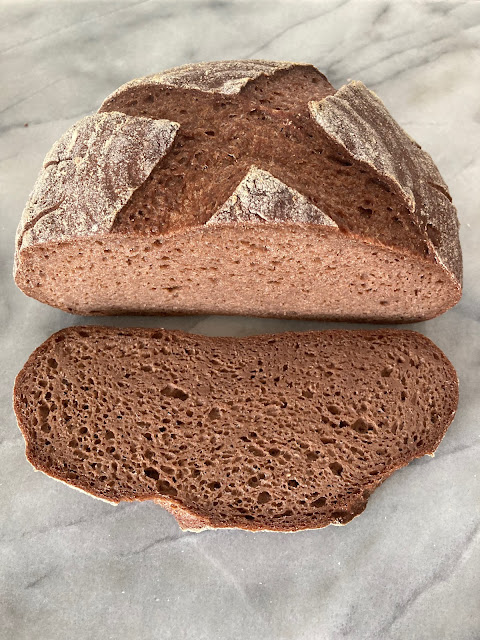Chia, Flax, and Psyllium as Binders in Gluten-free Bread Making
Xanthan gum and guar gum have been the default binders for gluten-free baking in the United States for years. However, these substances have their limitations. They have no nutrient value, for starters. Then there's the fact that they don't give you much in the way of flexibility or strength in your final baked good. Did you ever make a gluten-free cupcake that tasted like cardboard and crumbled apart in your hand as you tried to eat it? Even though you put twice as much liquid into the recipe than you would have for "regular"flour? You can blame xanthan gum for that.
The best binders out there for your gluten-free baking may not be what you thought they were. Chia, flax, and psyllium are the "it" girls of gluten-free bread baking right now. I'll tell you why and how.
Origin: Mexico and Central America
Remember the Chia Pet? The same seeds that you might have used to coat a clay doll to grow green "hair" is now the superfood darling of the moment. They are chock-full of omega-3s and antioxidants, among a slew of other nutrients. They are also extremely high in fiber. As it turns out, chia seed may be more than a fad for gluten-free bakers.
Used as a binder, ground chia seed lends a lot of flexibility to gluten-free dough. However, it doesn't add as much strength as other binders and is almost always used together with another binder. What this means is that chia can give your final bread a lot of softness and flexibility but by itself it doesn't lend the raw dough enough strength to hold up the bread as it rises. In addition to flexibility, chia seed helps gluten-free bread retain moisture and stay fresh longer.
I use ground chia seed as 25% or less of my binder for best results. Finely ground, I either whisk it into the liquids or mix it with the flour. Some recipes call for mixing it with boiling water before adding it to a recipe, but I have found no benefit to this method.

Flax Seed
Origin: Probably the Middle East or the Mediterranean
The flax plant has been used by humans for as long as 30,000 years. The fibers of the leaf are used to make linen, and other natural products such as linoleum. Ancient Romans used to snack on flax seeds like nuts. Flax seeds have many of the nutrients that chia seeds do, and they are also high in fiber, though some people find them more difficult to digest.
Flax seed provides moderate strength and flexibility to doughs as a gluten substitute. While it is effective enough to be used alone in breads baked in a pan, it gives you the best texture when combined with other binders such as chia seed or psyllium husk.
I use ground flax seed as 15-75% of my binder for best results. Finely ground, I either whisk it into the liquids or mix it with the flour. Some recipes call for mixing it with boiling water before adding it to a recipe, but I have found no benefit to this method. For 450 grams of flour, use about 60 grams of binder that is primarily flax seed.
Psyllium Husk
Origin: Europe, Russia, and India
Psyllium is the strongest binder I have found for gluten-free baking. It provides great strength and flexibility to gluten-free dough. If you are looking to bake a free-form loaf like a boule, batard, or baguette, psyllium should be your binder of choice.
I use psyllium as 75-100% or of my binder for best results. Whisk the binder into the liquids or the dry ingredients before combining all your ingredients. Some bakers claim that grinding psyllium improves its strength, and you should use 1/2 the amount of ground psyllium by weight. I haven't verified this. Some recipes call for mixing it with boiling water before adding it to a recipe, but I have found no benefit to this method. For 450 grams of flour, use about 25-30 grams of binder that is primarily whole psyllium husk.
Edit: Psyllium husk is also full of fiber!
Edit: Psyllium husk is also full of fiber!




Comments
Psyllium Husk
Ground psyllium is a stronger binder than whole, so you can use less. I use 20g finely-ground psyllium for 450g flour instead of the 30g whole psyllium.
I've replaced up to 30% of the whole psyllium with chia or flax seed without impacting the rise. In fact chia seed gives the crumb a bit of a more tender feel. I have only tried this with whole psyllium, as I've just started experimenting with ground psyllium again recently.
I don't use flax seed much because I have some indigestion from it on occasion. This is also pretty common for people to experience. It helps to grind it really well before using it.
I hope this info helps and happy baking!
I also notice that bananas help to bind other gluten free baked goods (muffins, pancakes) so I'm thinking of trying the "banana pain au-levain" recipe from TFL. I made it once several years ago (back when I used wheat) and it turned out fantastic, the banana taste was both subtle and delicious. I'm thinking it *might* make a good GF bread too, and the bananas definitely add some nutrition. http://www.thefreshloaf.com/node/14432/banana-pain-au-levain
http://glutenfree-jenny.com/pixie-dust-xanthan-gum-replacer/
Making chapatis (aka roti) with psyllium husk and any gluten free flour is a joy. I can't tell the difference between wheat chapati and gluten free glour with psyllium chapati. Magic!
And thank you for these wonderful and descriptive recipes. YOur writing is very clear & understandable. I am severely gluten intolerant, and I am so happy to have soem wonderful bread again!